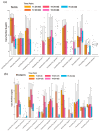A Comparative Longitudinal Study Analyzing Vaginal Microbiota Differences Between Term and Preterm Pregnancies in Korean Women
- PMID: 40283043
- PMCID: PMC12028669
- DOI: 10.3390/medicina61040752
A Comparative Longitudinal Study Analyzing Vaginal Microbiota Differences Between Term and Preterm Pregnancies in Korean Women
Abstract
Background and Objectives: Preterm birth (PTB), defined as delivery before 37 weeks of gestation, remains a significant public health concern due to its association with neonatal morbidity and mortality. Although studies have suggested that microbial factors in vaginal microbiota (VMB) influence PTB, longitudinal research on Korean women is limited. This study aimed to analyze VMB differences between term and preterm pregnancies in Korean women and their correlation with the cervical length (CL). Materials and Methods: A cohort of 60 pregnant Korean women (40 who had a term birth (TB) and 20 who had a PTB) was recruited. Vaginal samples were collected at five time points (first, second, and third trimester; 1-2 weeks postpartum; 1-2 months postpartum). Microbial DNA was extracted and analyzed using quantitative PCR targeting 12 bacterial species. The CL was measured in the second and third trimesters. Results: Lactobacillus crispatus was consistently dominant in the TB group, whereas PTB cases exhibited greater microbial diversity with elevated levels of Prevotella salivae and Ureaplasma species. The CL was significantly shorter in PTB cases, correlating with shifts in the VMB composition. Conclusions: A stable, Lactobacillus-dominant microbiome is protective in pregnancy, while increased diversity in PTB cases suggests microbial biomarkers for early risk prediction. Combining VMB profiling with CL measurement may enhance early, non-invasive PTB risk assessments.
Keywords: cervical length; longitudinal study; preterm birth; vaginal microbiota.
Conflict of interest statement
The authors declare no conflicts of interest.
Figures



Similar articles
-
Shotgun sequencing of the vaginal microbiome reveals both a species and functional potential signature of preterm birth.NPJ Biofilms Microbiomes. 2020 Nov 12;6(1):50. doi: 10.1038/s41522-020-00162-8. NPJ Biofilms Microbiomes. 2020. PMID: 33184260 Free PMC article.
-
Vaginal bacterial load in the second trimester is associated with early preterm birth recurrence: a nested case-control study.BJOG. 2021 Dec;128(13):2061-2072. doi: 10.1111/1471-0528.16816. Epub 2021 Jul 19. BJOG. 2021. PMID: 34139060
-
Lactobacillus-Depleted Vaginal Microbiota in Pregnant Women Living With HIV-1 Infection Are Associated With Increased Local Inflammation and Preterm Birth.Front Cell Infect Microbiol. 2021 Feb 11;10:596917. doi: 10.3389/fcimb.2020.596917. eCollection 2020. Front Cell Infect Microbiol. 2021. PMID: 33643930 Free PMC article.
-
Composition of the vaginal microbiota during pregnancy in women living in sub-Saharan Africa: a PRISMA-compliant review.BMC Pregnancy Childbirth. 2021 Sep 3;21(1):596. doi: 10.1186/s12884-021-04072-1. BMC Pregnancy Childbirth. 2021. PMID: 34479485 Free PMC article. Review.
-
Relationship of Lactobacillus Vaginal Microbiota Changes and the Risk of Preterm Birth: A Systematic Review and Meta-Analysis.J Womens Health (Larchmt). 2024 Feb;33(2):228-238. doi: 10.1089/jwh.2023.0393. Epub 2023 Dec 8. J Womens Health (Larchmt). 2024. PMID: 38064523
References
-
- Ohuma E.O., Moller A.-B., Bradley E., Chakwera S., Hussain-Alkhateeb L., Lewin A., Okwaraji Y.B., Mahanani W.R., Johansson E.W., Lavin T. National, regional, and global estimates of preterm birth in 2020, with trends from 2010: A systematic analysis. Lancet. 2023;402:1261–1271. doi: 10.1016/S0140-6736(23)00878-4. - DOI - PubMed
Publication types
MeSH terms
Grants and funding
LinkOut - more resources
Full Text Sources

